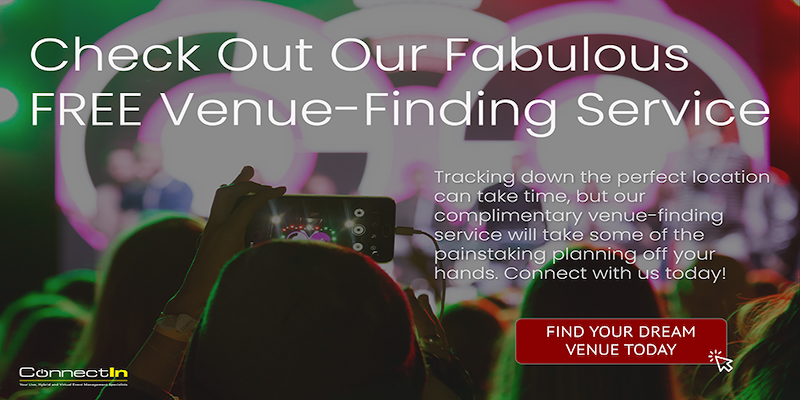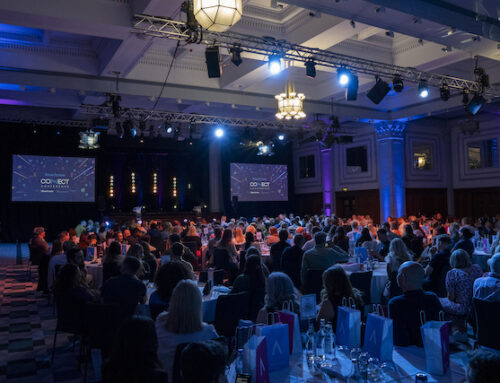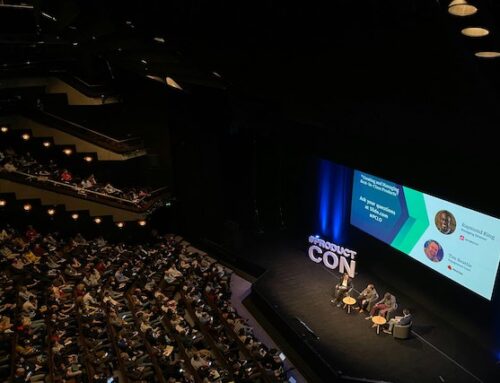
ConnectIn

When it comes to choosing between virtual and hybrid events, too many decisions are still made on gut feel rather than strategy. And it could be costing you.
You may have already seen the casualties up close: hybrid events where virtual attendees feel like an afterthought, virtual conferences that would’ve delivered more as hybrids. Then there are in-person occasions that ‘lost’ half their audience the moment the virtual event production angle was overlooked.
The events industry has largely embraced virtual and hybrid options — so why does this choice still feel like a coin toss for some teams? As we explored in our explainer of why virtual events are here to stay, these formats aren’t temporary fixes; they’re strategic tools that deserve serious consideration.
Here’s what we think: the difference between virtual and hybrid events isn’t just about technology or budget. It’s about understanding what each format actually delivers, then matching that to your goals. Virtual event production and hybrid event production each solve specific business problems; so flipping that coin should be a strict no-no.
Our blog breaks it down so you can make the right choice — without the guesswork — and avoid leaving money and engagement on the table.
The Difference Between Virtual and Hybrid Events
Understanding the difference between virtual and hybrid events starts with knowing what each format is designed to do, and how each might serve your business goals.
Virtual Event Production: The creation of digital-first experiences that go far beyond one-way webinars. These are fully online events built to drive engagement, deliver measurable outcomes, and often rival (or even outperform) in-person gatherings.
By removing the limits of a physical venue, virtual events allow you to focus on what really matters: high-quality content, interactivity, and analytics that show what’s working. They demand stable platforms, intentional design for digital attention spans, and a mindset that values participation, not just presentation. Think of it not as broadcasting, but as creating a shared space where your message brings people together — and forms communities.
When executed well, virtual events can cut costs, scale reach, and deliver deeper data insights than traditional live alternatives. That makes them a powerful tool in today’s marketing and comms strategy.
Hybrid Event Production: Blends the best of both worlds: physical and virtual. It’s not about livestreaming your in-person event and calling it a day. True hybrid events are designed to give equal value to both audiences — even though they experience the event in very different ways.
This dual-audience approach requires careful planning. From production setup to engagement tactics to success metrics, each audience needs a tailored experience. Done right, hybrid events connect the two groups in meaningful ways: remote attendees can ask live questions, virtual speakers can address in-person audiences, and everyone can network across platforms.
Strategically, hybrid events offer expanded reach and that premium in-room energy. But they do come with more complexity — and require a level of production expertise that ensures all that extra investment actually pays off.
Matching an Event Format to the Ideal Occasion
Virtual and hybrid events each offer distinct areas of strength that can elevate different types of experience. As a result, the sharpest planners excel by aligning event goals with the production style to enhance reach, boost engagement, and deliver ideal outcomes. Smart planners don’t just follow trends — they match format to function. Here’s how.
Virtual Event Production is Great For:
- Training Programs: Where learning is the number one objective.
- Global Conferences: To accommodate international conference speakers and attendees across different time zones.
- Product Launches: Brand activations and product reveals help to target broad demographics across borders.
- Industry Gatherings: Whether you’re sharing insights, or focused more on networking, everything is made easier by more structured interactions.
- AGMs: Where the promise of information sharing outweighs the need for face-to-face relationship building.
Virtual event production works best when content is the main attraction and reach is crucial. The difference between virtual and hybrid events becomes clear when we take into account scale, as virtual events can accommodate monster audience growth without incurring the jump in cost that expanding often brings. Who wouldn’t want to get on board with that?!
Hybrid Event Production Thrives at:
- Executive Conferences: Because relationship building can directly drive business development.
- Award Ceremonies: The burst of live audience energy and ‘in the moment’ emotional impact is a real fuel injection at awards shows.
- Product Demos: Ideal for hands-on interaction/experiences.
- Board Meetings: Specifically when governance is the topic and remote stakeholders should be in attendance.
- Industry Conferences: Featuring live presentations, equipment demonstrations, or hands-on training.
Hybrid event production makes sense when human connection influences business outcomes — and when you can justify the extra complexity with premium pricing or strategic positioning. These events often feature exclusive access, experiential features, or content that genuinely benefits from the energy of a live audience. If these elements aren’t included in your plans, it could be time to chew over other formats.
Pros and Cons of Virtual Vs Hybrid
You’ve no doubt gathered by now that both of these formats offer pretty unique benefits. Let’s skip the jargon by weighing up the pros and cons of virtual and hybrid events. Here’s what each of these options actually delivers when the lights are on, the cameras are rolling, and the stakes are high.
Virtual Events: Best When You Want…
- Serious ROI: Virtual events can deliver bigger returns (without the venue/catering bills or prop sourcing).
- Global Scale: Reach anyone, anywhere. No passports or flight delays to be seen!
- On-demand Magic: Record once, distribute forever — perfect for long-term lead generation.
- Useable Data: Behavioural analytics that blow in-person guesswork out of the water.
- Green Machine: Slash travel emissions and smash your sustainability targets.
- Low-Risk: No extreme weather conditions or travel strikes to worry about!
Word of Warning: Virtual can sometimes struggle with meaningful networking. Plus, shorter attention spans among less digital-savvy audiences could see you losing a few eyeballs along the way.
Hybrid Events: Best When You Want…
- The Best of Both Worlds: The magic of live energy and global reach in one complete package.
- Premium Relationships: Perfect for blue chip networking, deal-making, and client retention.
- Tiered Pricing: Use the option to sell VIP seats in person, while providing quality e-content for remote guests.
- Futureproofing: If travel plans or venue access gets dicey, you’ve still got that all-important hybrid reach.
- Sponsor Firepower: More visibility = more value.
Word of Warning: Hybrid is not just “virtual + venue”. For all but seasoned planners, it can be more complex, more pricey, and requires the dedication and application of a marathon run. To hit the heights, you’ll need proper tech, proper talent, and a lot more time to play with.
The 5 Questions That Should Guide Your Decision-Making
Choosing between virtual and hybrid events comes down to answering five simple questions that will make the right format bubble up to the top.
The following teasers will illuminate what’s actually possible — and what will work best with the time, money, and team you’ve got at your disposal.
1. What’s Your Actual Budget?
Be comprehensive. Include all costs, not just platform fees.
- Virtual events can cost anything from £8k up — depending on production quality.
- Hybrid events often start from a similar base, with full-scale productions reaching anything up to £80k. When you factor in venue hire, AV assistance, entertainment, etc., costs can rise quickly.
Essentially, if you’re working with a limited budget, hybrid formats are likely out of reach unless you DIY heavily (which could jeopardise the quality of both experiences).
2. Where’s Your Audience Based?
- Virtual events shine with geographically distant attendees and multiple time zones.
- Hybrid events are strongest with a concentrated regional base and a sprinkling of remote participants.
The crux? Choose virtual if your audience covers several time zones, choose hybrid if most are local but you want extra reach.
3. What Drives Success?
Match the format to the preferred outcomes. This means:
- Virtual suits goals like lead generation, training, or analytics-driven content delivery.
- Hybrid is worth it when in-person networking, deal-making, or premium experiences justify higher costs.
In short: Let your goals decide the format. Not your assumptions.
4. How Much Time Do You Have?
To give you a rough idea, the planning timelines for virtual and hybrid events are as follows:
- Virtual: ~12–16 weeks
- Hybrid: ~16–24 weeks
If you choose to go hybrid, remember to factor in enough time for important stuff like venue sourcing, catering, and rehearsals for both live and virtual audiences.
5. What Can Your Team Handle?
- Virtual events require digital marketing, platform management, and online engagement skills.
- Hybrid events add ‘traditional’ event coordination, live AV management, a dual-audience, and more into the mix.
Lacking the experience to handle this? Factor in costs for an external event manager to orchestrate the whole shebang on time, in budget, and without any costly fumbles.
ConnectIn Events: No Guesswork, Just Results.
Choosing between virtual and hybrid events doesn’t have to feel like a gamble. When you cut through the fluff and focus on what each format actually delivers, the right path should become clear. Virtual events are unbeatable for reach, cost-efficiency, and analytics. Hybrid events shine when relationship-building, high-impact moments, and VIP access are mission-critical. And yet, they demand more time, budget, and expertise to perfect.
The trick, then, is picking the one that fits your circumstances. And that’s where ConnectIn Events comes in.
With over 15 years of experience, a warm, straight-talking team, and trusted contacts across the UK, we turn even tight budgets into stand-out experiences. Whether you need end-to-end production, strategic guidance, or a helping hand with one small element, we’ve got you covered. Virtual or hybrid, we make events that not only work but feel stress-free and simple.
Get in touch today to create a flawless showcase for your business.
Share this post
Related posts
- Unique Venues Manchester: 12 Unusual Spaces That Make Events Unmissable
- 7 Best Venues in Manchester for Corporate Events
- 7 Reasons You Need a Hybrid Event Planner for Your Next Corporate Event
- Event Trends 2026: How to Create Corporate Events People Remember
- The Ultimate Hybrid Event Planning Checklist (for Corporate Events)





